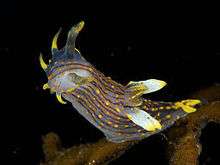Polycera quadrilineata
| Fourline nudibranch Polycera quadrilineata | |
|---|---|
.jpg) | |
| Polycera quadrilineata from France | |
| Scientific classification | |
| Kingdom: | Animalia |
| Phylum: | Mollusca |
| Class: | Gastropoda |
| (unranked): | clade Heterobranchia clade Euthyneura |
| Superfamily: | Polyceroidea |
| Family: | Polyceridae |
| Subfamily: | Polycerinae |
| Genus: | Polycera |
| Species: | P. quadrilineata |
| Binomial name | |
| Polycera quadrilineata (O. F. Müller, 1776)[1] | |
| Synonyms[2] | |
| |
Polycera quadrilineata, is a sea slug, a species of dorid nudibranch. It is a marine gastropod mollusc in the family Polyceridae. The specific epithet quadrilineata means four-lined and refers to the four longitudinal black lines present on the original specimen. This species is sometimes called the fourline nudibranch.
Distribution
This nudibranch is described originally from Norway. In the NE Atlantic it is a common species in shallow water.[3] It is distributed from Greenland to Norway and south along the European coasts into the Mediterranean Sea. It has also been reported off the South African coast from the Atlantic coast of the Cape Peninsula to Algoa Bay. The South African animals differ in having six instead of four papillae projecting from the frontal margin of the head, plus details of the coloration. It is found from the intertidal zone to 160 m.

Description
The fourline nudibranch is a smooth-bodied variably coloured nudibranch. The ground colour is white or grey and there are usually black, yellow or orange stripes longitudinally along the notum, though these can be absent. The head has four or occasionally six yellow projections. The gills and rhinophores are translucent white, tipped with yellow. In the South African animals the gills and rhinophores are black, and may be spotted with yellow. Alongside the gills is a pair of yellow-tipped projections. The animal may reach 20mm in total length. It is distinguished from the crowned nudibranch in having raised yellow spots on the mid-dorsal region. [4] [5]
Ecology
Polycera quadrilineata feeds mostly on the bryozoans Membranipora membranacea and Electra pilosa.[3]
References
- ↑ Müller, Otto Frederik. (1776) Zoologiae Danicae. Prodromus seu animalium Daniae et Norvegiae ingenarum characteres, nomina, et synonyma imprimis popularium, xxxii + 282 pp.
- ↑ WoRMS: Polycera quadrilineata; accessed : 30 September 2010
- 1 2 Picton, B.E. & Morrow, C.C., 2010. Polycera quadrilineata [In] Encyclopedia of Marine Life of Britain and Ireland.
- ↑ Thompson, T.E. 1988. Molluscs: Benthic Opisthobranchs Linnean Society of London. ISBN 90 04 08439 8
- ↑ Gosliner, T.M. 1987. Nudibranchs of Southern Africa ISBN 0-930118-13-8
- Montagu G., 1804: Description of several marine animals found on the South coast of Devonshire ; Transactions of the Linnean Society of London 7: 61-85
- Rathke J., 1806: [in] Müller O. F., Zoologia Danica ed. III
- Risso A., 1826-1827: Histoire naturelle des principales productions de l'Europe Méridionale et particulièrement de celles des environs de Nice et des Alpes Maritimes; Paris, Levrault
- Orbigny A. D. d', 1837: Mémoire sur des espèces et sur des genres nouveaux de l'ordre des nudibranches observés sur les côtes de France ; Revue et Magasin de Zoologie 7 (5): 1-16
- Thompson W., 1840: Contributions towards a knowledge of the Mollusca Nudibranchia and Mollusca Tunicata of Ireland, with descriptions of some apparently new species of Invertebrata ; Annals and Magazine of Natural History 5 (29): 84-102
- Ihering H. von, 1886: Beiträge zur kenntnis der Nudibranchien des Mittelmeeres. Part 2; Malakozoologische Blätter N.F. 8: 12-48
- Dautzenberg P. & Durouchoux P., 1913-1914: Les mollusques de la baie de Saint-Malo: Feuille des Jeunes Naturalistes 43-44 (Suppl.): 1-64, pl. 1-4
- Labbé A., 1931: Les Polycerades de la station du Croisic et description sommaire d'une espèce nouvelle : Polycera salamandra n. sp.; Bulletin de la Société Zoologique de France 56 : 19-24.
| Wikimedia Commons has media related to Polycera quadrilineata. |